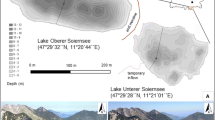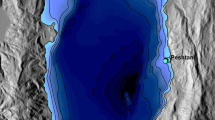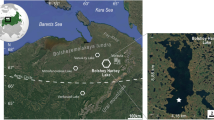Abstract
A sample of a sediment record contains diatom species that have grown in disparate habitats and eventually accumulated in a deep part of the lake. The original habitats may differ in substrate, depth location, and availability of resources. Identifying the species characteristic of each habitat should improve our ecological and environmental interpretation of the sediment record by distinguishing habitat specific responses. With this aim, we studied the benthic diatom communities of a deep oligotrophic lake across several habitats. The main source of variation in the diatom composition was the substrate type; particularly, sediment biofilms. Depth was the second factor. The thermocline defined a shift in diatom communities that also included changes in the dominant lifeforms. A third factor was the mesoscale heterogeneity (i.e., rock sides). Although most species were present in many habitats, characteristic species were identified for all the main habitats and used for an improved interpretation of the deep sediment record. Appropriate standardization showed increasing species richness and diversity from epilimnetic epilithic samples to hypolimnetic sediment samples. We estimate that more than 5000 valve counts are required for appropriate comparisons. Consequently, in sediment records with lower counts per sample, one has to amalgamate samples—losing temporal resolution—to achieve reliable analyses of diversity changes over time. Deep sediment samples are representative of the gamma-diversity of the lake diatom metacommunity, which result from the local alpha diversity of the habitats and the beta-diversity of the variability in composition among them. This double source of diversity has to be taken into account when using the sediment record for estimating lake biodiversity changes. On the other hand, we show that an estimation of the spatial (habitat) heterogeneity of a reconstructed environmental variable can be achieved using subsets of species characteristic of each habitat. We demonstrate the procedure by reconstructing the pH fluctuations during the last 200 years in several habitats from a single sediment record. The results are coherent with the expected differences between predominantly trophogenic or tropholithic habitats.









Similar content being viewed by others
References
Althouse B, Higgins S, Zanden MJV (2014) Benthic and planktonic primary production along a nutrient gradient in Green Bay, Lake Michigan, USA. Freshw Sci 33:487–498
Anderson NJ, Battarbee RW (1994) Aquatic community persistence and variability: a palaeolimnological perspective. In: Giller PS, Hildrew AG, Raffaelli D (eds) Aquatic ecology: scale, pattern and process. Blackwell, Oxford, pp 233–259
Bao R, Hernandez A, Saez A, Giralt S, Prego R, Pueyo JJ, Moreno A, Valero-Garces BL (2015) Climatic and lacustrine morphometric controls of diatom paleo productivity in a tropical Andean lake. Quaternary Sci Rev 129:96–110
Battarbee RW, Jones VJ, Flower RJ, Cameron NG, Bennion H, Carvalho L, Juggins S (2001) Diatoms. In: Smol JP, Birks HJB, Last WM (eds) Tracking environmental change using lake sediments, vol 3. Terrestrial, algal, and siliceous indicators. Kluwer Academic Publishers, Dordrecht, pp 155–202
Birks HJB, Felde VA, Bjune AE, Grytnes J-A, Seppä H, Giesecke T (2016) Does pollen-assemblage richness reflect floristic richness? A review of recent developments and future challenges. Rev Palaeobot Palynol 228:1–25
Borchardt MA (1996) Nutrients. In: Stevenson RJ, Bothwell ML, Lowe RL (eds) Algal ecology: freshwater benthic ecosystems. Academic Press, San Diego, pp 183–227
Buchaca T, Catalan J (2007) Factors influencing the variability of pigments in the surface sediments of mountain lakes. Freshw Biol 52:1365–1379
Burkholder JM (1996) Interactions of benthic algae with their substrata. In: Stevenson RJ, Bothwell ML, Lowe RL (eds) Algal ecology: freshwater benthic ecosystems. Academic Press, San Diego, pp 253–297
Camarero L, Catalan J (1993) Chemistry of bulk precipitation in the central and eastern Pyrenees, northeast Spain. Atmos Environ A-Gen 27:83–94
Camarero L, Catalan J (2012) Atmospheric phosphorus deposition may cause lakes to revert from phosphorus limitation back to nitrogen limitation. Nat Commun 3:1118
Cameron NG, Birks HJB, Jones VJ, Berges F, Catalan J, Flower RJ, Garcia J, Kawecka B, Koinig KA, Marchetto A, Sánchez-Castillo P, Schmidt R, Šiško M, Solovieva N, Štefková E, Toro M (1999) Surface-sediment and epilithic diatom pH calibration sets for remote European mountain lakes (AL:PE Project) and their comparison with the Surface Waters Acidification Programme (SWAP) calibration set. J Paleolimnol 22:291–317
Cantonati M, Lowe RL (2014) Lake benthic algae: toward an understanding of their ecology. Freshw Sci 33:475–486
Cantonati M, Scola S, Angeli N, Guella G, Frassanito R (2009) Environmental controls of epilithic diatom depth-distribution in an oligotrophic lake characterized by marked water-level fluctuations. Eur J Phycol 44:15–29
Catalan J (1988) Physical properties of the environment relevant to the pelagic ecosystem of a deep high-mountain lake (Estany Redo, Central Pyrenees). Oecol Aquat 9:89–123
Catalan J (1989) The winter cover of a high-mountain Mediterranean lake (Estany Redó, Pyrenees). Water Resour Res 25:519–527
Catalan J, Camarero L (1993) Seasonal changes in alkalinity and pH in two Pyrenean lakes of very different water residence time. Verh Internat Verein Limnol 25:749–753
Catalan J, Pla S, Rieradevall M, Felip M, Ventura M, Buchaca T, Camarero L, Brancelj A, Appleby PG, Lami A, Grytnes A, Agusti-Panareda A, Thompson R (2002a) Lake Redo ecosystem response to an increasing warming in the Pyrenees during the twentieth century. J Paleolimnol 28:129–145
Catalan J, Ventura M, Brancelj A, Granados I, Thies H, Nickus U, Korhola A, Lotter AF, Barbieri A, Stuchlik E, Lien L, Bitusik P, Buchaca T, Camarero L, Goudsmit GH, Kopacek J, Lemcke G, Livingstone DM, Muller B, Rautio M, Sisko M, Sorvari S, Sporka F, Strunecky O, Toro M (2002b) Seasonal ecosystem variability in remote mountain lakes: implications for detecting climatic signals in sediment records. J Paleolimnol 28:25–46
Catalan J, Camarero L, Felip M, Pla S, Ventura M, Buchaca T, Bartumeus F, Mendoza Gd, Miró A, Casamayor EO, Medina-Sánchez JM, Bacardit M, Altuna M, Bartrons M, Quijano DDd (2006) High mountain lakes: extreme habitats and witnesses of environmental changes. Limnetica 25:581–584
Catalan J, Pla S, Garcia J, Camarero L (2009) Climate and CO2 saturation in an alpine lake throughout the Holocene. Limnol Oceanogr 54:2542–2552
Catalan J, Pla-Rabés S, Wolfe AP, Smol JP, Rühland KM, Anderson NJ, Kopáček J, Stuchlík E, Schmidt R, Koinig KA, Camarero L, Flower RJ, Heiri O, Kamenik C, Korhola A, Leavitt PR, Psenner R, Renberg I (2013) Global change revealed by palaeolimnological records from remote lakes: a review. J Paleolimnol 49:513–535
Chao A, Gotelli NJ, Hsieh TC, Sander EL, Ma KH, Colwell RK, Ellison AM (2014) Rarefaction and extrapolation with Hill numbers: a framework for sampling and estimation in species diversity studies. Ecol Monogr 84:45–67
Cleveland WS, Grosse E, Shyu WM, Chambers JM, Hatie TJ (1993) Local regression models. Statistical Models in S. Chapman & Hall, London, pp 309–376
Colwell RK, Coddington JA (1994) Estimating terrestrial biodiversity through extrapolation. Philos Trans R Soc B 345:101–118
Davidson TA, Reid MA, Sayer CD, Chilcott S (2013) Palaeolimnological records of shallow lake biodiversity change: exploring the merits of single versus multi-proxy approaches. J Paleolimnol 49:431–446
De Cáceres M, Legendre P, Moretti M (2010) Improving indicator species analysis by combining groups of sites. Oikos 119:1674–1684
De’ath G (2002) Multivariate regression trees: a new technique for modeling species–environment relationships. Ecology 83:1105–1117
Douglas MSV, Smol JP (1995) Periphytic diatom assemblages from high arctic ponds. J Phycol 31:60–69
Dufrene M, Legendre P (1997) Species assemblages and indicator species: the need for a flexible asymmetrical approach. Ecol Monogr 67:345–366
Falkowski PG, Owens TG (1980) Light—Shade adaptation. Plant Physiol 66:592–595
Felip M, Catalan J (2000) The relationship between phytoplankton biovolume and chlorophyll in a deep oligotrophic lake: decoupling in their spatial and temporal maxima. J Plankton Res 22:91–105
Fritz S (2008) Deciphering climatic history from lake sediments. J Paleolimnol 39:5–16
Fritz SC, Anderson NJ (2013) The relative influences of climate and catchment processes on Holocene lake development in glaciated regions. J Paleolimnol 49:349–362
Gerten D, Adrian R (2002) Effects of climate warming, North Atlantic Oscillation, and El Niño-Southern Oscillation on thermal conditions and plankton dynamics in Northern hemispheric lakes. Sci World J 2:586–606
Gotelli NJ, Colwell RK (2001) Quantifying biodiversity: procedures and pitfalls in the measurement and comparison of species richness. Ecol Lett 4:379–391
Gotelli NJ, Ellison AM (2013) A primer of ecological statistics. Sinauer, Sunderland
Gregory-Eaves I, Beisner BE (2011) Palaeolimnological insights for biodiversity science: an emerging field. Freshw Biol 56:2653–2661
Hader DP, Kumar HD, Smith RC, Worrest RC (2007) Effects of solar UV radiation on aquatic ecosystems and interactions with climate change. Photoch Photobiol Sci 6:267–285
Hill W (1996) Effects of light. In: Stevenson RJ, Bothwell ML, Lowe RL (eds) Aquatic ecology series; algal ecology: freshwater benthic ecosystems. Academic Press, San Diego, pp 121–148
Hoagland KD, Peterson CG (1990) Effects of light and wave disturbance on vertical zonation of attached microalgae in a large reservoir. J Phycol 26:450–457
Jackson ST, Blois JL (2015) Community ecology in a changing environment: perspectives from the quaternary. Proc Natl Acad Sci USA 112:4915
Jost L (2006) Entropy and diversity. Oikos 113:363–375
Jost L (2010) The relation between evenness and diversity. Diversity 2:207–232
Karlsson J, Bystrom P, Ask J, Ask P, Persson L, Jansson M (2009) Light limitation of nutrient-poor lake ecosystems. Nature 460:506–U580
Kingston JC, Lowe RL, Stoermer EF, Ladewski TB (1983) Spatial and temporal distribution of benthic diatoms in Northern Lake Michigan. Ecology 64:1566–1580
Krammer K, Lange-Bertalot H (1986) Bacillariophyceae. Naviculaceae 2/1. Gustav Fischer Verlag, Stuttgart, p 876
Krammer K, Lange-Bertalot H (1988) Bacillariophyceae. Bacillariaceae, Epithemiaceae Surirellaceae 2/2. Gustav Fischer Verlag, Stuttgart, p 596
Krammer K, Lange-Bertalot H (1991a) Bacillariophyceae. Achnanthaceae 2/4. Gustav Fischer Verlag, Stuttgart, p 473
Krammer K, Lange-Bertalot H (1991b) Bacillariophyceae. Centrales, Fragilariaceae, Eunotiaceae 2/3. Gustav Fischer Verlag, Stuttgart, p 576
Laird KR, Kingsbury MV, Cumming BF (2010) Diatom habitats, species diversity and water-depth inference models across surface-sediment transects in Worth Lake, northwest Ontario, Canada. J Paleolimnol 44:1009–1024
Lange K, Liess A, Piggott JJ, Townsend CR, Matthaei CD (2011) Light, nutrients and grazing interact to determine stream diatom community composition and functional group structure. Freshw Biol 56:264–278
Laurion I, Ventura M, Catalan J, Psenner R, Sommaruga R (2000) Attenuation of ultraviolet radiation in mountain lakes: factors controlling the among- and whitin-lake variability. Limnol Oceanogr 45:1274–1288
Law AC, Anderson NJ, McGowan S (2015) Spatial and temporal variability of lake ontogeny in south-western Greenland. Quat Sci Rev 126:1–16
Legendre P, Gallagher ED (2001) Ecologically meaningful transformations for ordination of species data. Oecologia 129:271–280
Legendre P, Legendre L (1998) Numerical ecology. Elsevier, Amsterdam
Leibold MA, Holyoak M, Mouquet N, Amarasekare P, Chase JM, Hoopes MF, Holt RD, Shurin JB, Law R, Tilman D, Loreau M, Gonzalez A (2004) The metacommunity concept: a framework for multi-scale community ecology. Ecol Lett 7:601–613
Lim DSS, Kwan C, Douglas MSV (2001) Periphytic diatom assemblages from Bathurst Island, Nunavut, Canadian High Arctic: an examination of community relationships and habitat preferences. J Phycol 37:379–392
Logue J, Mouquet N, Peter H, Hillebrand H, Metacommunity Working G (2011) Empirical approaches to metacommunities: a review and comparison with theory. Trends Ecol Evol 26:482–491
Lowe RL (1996) Periphyton patterns in lakes. In: Stevenson RJ, Bothwell ML, Lowe RL (eds) Aquatic ecology series; algal ecology: freshwater benthic ecosystems. Academic Press, San Diego, pp 57–76
Luttenton MR, Lowe RL (2006) Response of a lentic periphyton community to nutrient enrichment at low N:P ratios. J Phycol 42:1007–1015
Maberly SC, King L, Dent MM, Jones RI, Gibson CE (2002) Nutrient limitation of phytoplankton and periphyton growth in upland lakes. Freshw Biol 47:2136–2152
Magurran AE, McGill BJ (2011) Biological diversity, frontiers in measurement and assessment. Oxford University Press, Oxford
Marks JC, Lowe RL (1993) Interactive effects of nutrient availability and light levels on the periphyton composition of a large oligotrophic lake. Can J Fish Aquat Sci 50:1270–1278
McGill BJ, Enquist BJ, Weiher E, Westoby M (2006) Rebuilding community ecology from functional traits. Trends Ecol Evol 21:178–185
Michelutti N, Holtham AJ, Douglas MSV, Smol JP (2003) Periphytic diatom assemblages from ultra-oligotrophic and UV transparent lakes and ponds on Victoria Island and comparisons with other diatom surveys in the Canadian Arctic. J Phycol 39:465–480
Passy SI (2007) Diatom ecological guilds display distinct and predictable behavior along nutrient and disturbance gradients in running waters. Aquat Bot 86:171–178
Peterson CG (1996) Response of algae to natural physical disturbance. In: Stevenson RJ, Bothwell ML, Lowe RL (eds) Algal ecology: freshwater benthic ecosystems. Academic Press, San Diego, pp 373–402
Pla S, Catalan J (2005) Chrysophyte cysts from lake sediments reveal the submillennial winter/spring climate variability in the northwestern Mediterranean region throughout the Holocene. Clim Dynam 24:263–278
Pla-Rabes S, Flower RJ, Shilland EM, Kreiser AM (2011) Assessing microbial diversity using recent lake sediments and estimations of spatio-temporal diversity. J Biogeogr 38:2033–2040
Pla-Rabes S, Toro M, Van De Vijver B, Rochera C, Villaescusa JA, Camacho A, Quesada A (2013) Stability and endemicity of benthic diatom assemblages from different substrates in a maritime stream on Byers Peninsula, Livingston Island, Antarctica: the role of climate variability. Antarct Sci 25:254–269
R Development Core Team (2016) R: a language and environment for statistical computing. R Foundation for Statistical Computing, Vienna
Rantala MV, Luoto TP, Weckström J, Perga M-E, Rautio M, Nevalainen L (2015) Climate controls on the Holocene development of a subarctic lake in Northern Fennoscandia. Quat Sci Rev 126:175–185
Rimet F, Bouchez A (2012) Life-forms, cell-sizes and ecological guilds of diatoms in European rivers. Knowl Manag Aquat Ecosyst 406:1–12
Rivera-Rondón CA, Catalan J (2017) Diatom diversity in the lakes of the Pyrenees: an iconographic reference. Limnetica 36:127–396
Rosenzweig ML (1995) Species diversity in space and time. Cambridge University Press, Cambridge, p 427
Ryves DB, Battarbee RW, Fritz SC (2009) The dilemma of disappearing diatoms: incorporating diatom dissolution data into palaeoenvironmental modelling and reconstruction. Quat Sci Rev 28:120–136
Sánchez-López G, Hernández A, Pla-Rabes S, Toro M, Granados I, Sigró J, Trigo RM, Rubio-Inglés MJ, Camarero L, Valero-Garcés B, Giralt S (2015) The effects of the NAO on the ice phenology of Spanish alpine lakes. Clim Change 130:111–113
Saros JE, Stone JR, Pederson GT, Slemmons KEH, Spanbauer T, Schliep A, Cahl D, Williamson CE, Engstrom DR (2012) Climate-induced changes in lake ecosystem structure inferred from coupled neo- and paleoecological approaches. Ecology 93:2155–2164
Sayer CD, Davidson TA, Jones JI, Langdon PG (2010) Combining contemporary ecology and palaeolimnology to understand shallow lake ecosystem change. Freshw Biol 55:487–499
Stevens LR, Stone JR, Campbell J, Fritz SC (2006) A 2200-yr record of hydrologic variability from Foy Lake, Montana, USA, inferred from diatom and geochemical data. Quat Res 65:264–274
Stone J, Fritz SC (2004) Three-dimensional modeling of lacustrine diatom habitat areas: improving paleolimnological interpretation of planktic: benthic ratios. Limnol Oceanogr 49:1540–1548
ter Braak CJF, Šmilauer P. (2012) Canoco Reference Manual and User’s Guide: Software for Ordination (version 5.0). Microcomputer power, Itaca, www.canoco.com, Wageningen
Vadeboncoeur Y, Lodge DM (2000) Periphyton production on wood and sediment: substratum-specific response to laboratory and whole-lake nutrient manipulations. J N Am Benthol Soc 19:68–81
Vadeboncoeur Y, Kalff J, Christoffersen K, Jeppesen E (2006) Substratum as a driver of variation in periphyton chlorophyll and productivity in lakes. J N Am Benthol Soc 25:379–392
Vadeboncoeur Y, Devlin SP, McIntyre PB, Zanden MJV (2014) Is there light after depth? Distribution of periphyton chlorophyll and productivity in lake littoral zones. Freshw Sci 33:524–536
Ventura M, Camarero L, Buchaca T, Bartumeus F, Livingstone DM, Catalan J (2000) The main feature of seasonal variability in the external forcing and dynamics of a deep mountain lake (Redo, Pyrenees). J Limnol 59:97–108
Willis KJ, Bailey RM, Bhagwat SA, Birks HJB (2010) Biodiversity baselines, thresholds and resilience: testing predictions and assumptions using palaeoecological data. Trends Ecol Evol 25:583–591
Wolin JA, Duthie HC (2010) Diatoms as indicators of water level change in freshwater lakes. In: Smol J, Stoermer EF (eds) The diatoms applications for the environmental and earth sciences. Cambridge University Press, Cambridge, pp 174–185
Yang H, Flower RJ (2012) Effects of light and substrate on the benthic diatoms in an oligotrophic lake: a comparison between natural and artificial substrates 1. J Phycol 48:1166–1177
Acknowledgements
This work was supported by research Grants (LACUS and TRANSFER) from the Spanish Government (Ministerio de Economía y Competitividad, ref. CGL2013-45348-P and CGL2016-80124-C2-1-P). We thank Kike Ballesteros, Mikel Zabala, Jaume Piera, and David Diaz for carrying out the scuba diving part of the survey.
Author information
Authors and Affiliations
Corresponding author
Electronic supplementary material
Below is the link to the electronic supplementary material.
Rights and permissions
About this article
Cite this article
Pla-Rabés, S., Catalan, J. Diatom species variation between lake habitats: implications for interpretation of paleolimnological records. J Paleolimnol 60, 169–187 (2018). https://doi.org/10.1007/s10933-018-0017-0
Received:
Accepted:
Published:
Issue Date:
DOI: https://doi.org/10.1007/s10933-018-0017-0




